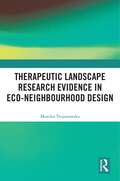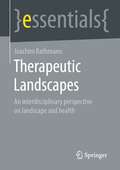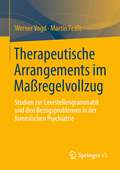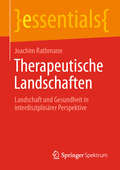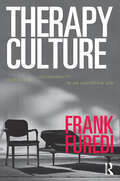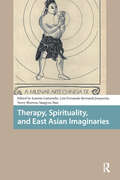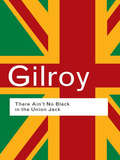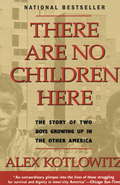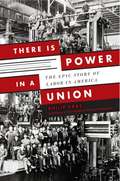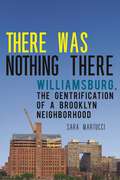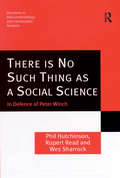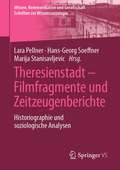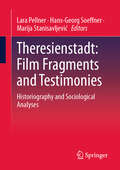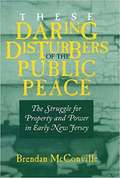- Table View
- List View
Therapeutic Cultural Routines to Build Family Relationships: Talk, Touch & Listen While Combing Hair©
by Marva L. Lewis Deborah J. WeatherstonSocial workers and Infant and Early Childhood Mental Health (IECMH) helpers need practical, relationship-based clinical tools to support families experiencing stress, separation, and loss. Research reveals key parenting behaviors occur during hair combing interaction (HCI) – lively verbal interaction, sensitive touch, and responsiveness to infant cues. This book explores how the simple routine of combing hair serves as an emotionally powerful, trauma-informed, culturally valid therapeutic tool for use by mental health helpers. HCI offers a low-cost opportunity for IECMH helpers to engage families and sustain attachment relationships. In this book, case studies illustrate the use of HCI with diverse families of color. Each chapter includes questions for reflective supervision to understand sociocultural factors that may shape behaviors during HCI. Topics included in the text: The Observing Professional and the Parent’s Ethnobiography Introduction to Reflective Supervision: Through the Lens of Culture, Diversity, Equity, and Inclusion A Case Study in Cross-Racial Practice and Supervision: Reflections in Black and White Tools to Disrupt Legacies of Colorism: Perceptions, Emotions, and Stories of Childhood Racial Features Therapeutic Cultural Routines to Build Family Relationships: Talk, Touch & Listen While Combing Hair© is a unique resource for counselors, psychologists, psychiatrists, home visiting nurses, early childhood educators, and family therapists who work with military families or multiracial families with bi-racial children.“This book provides practical insights useful for professionals and parents. The authors share compelling experiences using strength-based and rich cultural approaches guided by reflective practice. It deserves to be widely read and become a classic resource.” Robert N. Emde, Emeritus Professor of Psychiatry, University of Colorado School of Medicine
Therapeutic Culture: Triumph and Defeat
by Donileen LosekeFor nearly half a century, social scientists have made claims that there is a "therapeutic ethos" with extensive influence upon numerous aspects of American society. In Therapeutic Culture, twelve authors address the implications of this ethos and its effects on a wide range of social institutions, extending from the family to schools, and operating in religious behavior and within the legal system. Has there been, as the sociological theorist Philip Rieff argued in 1966, a "triumph of the therapeutic?" If so, in what kinds of institutions has it been most pervasive? At the same time, what aspects of modern culture has it replaced or defeated? Therapeutic Culture addresses these questions, and raises others. Part 1 of this volume examines the emergence of the idea of "authenticity" as it defines the manipulation of emotions and behavior both in the United States and Great Britain. Contributors include Elisabeth Lasch-Quinn, Frank Furedi, Jonathan B. Imber, and Alan Woolfolk. Part 2 illustrates specific cases of the effects of therapeutic culture within institutions, including courts, schools, religious communities, and the "virtual community" of the Internet. Contributors include James L. Nolan, Jr., John Steadman Rice, Felicia Wu Song, and James Tucker. Part 3 extends the analyses of specific social institutions to the broader consequences that have resulted as a therapeutic ethos has taken root in contemporary life. Contributors include Digby Anderson, Ellen Herman, and James Davison Hunter. Part 4 is devoted to a previously unpublished essay by Philip Rieff whose significant influence can be seen in many of the contributions. Rieff revisits the highly controversial confirmation hearings of Supreme Court Associate Justice Clarence Thomas in 1991 and offers ample evidence of the therapeutic uses of politics as well as the political manipulations available within a therapeutic culture to provide a fitting conclusion. This volume establishes a benchmark for furthe
Therapeutic Landscape Research Evidence in Eco-neighbourhood Design
by Monika TrojanowskaThis book presents how to recreate therapeutic landscapes in everyday places of eco-neighbourhoods. The concept of eco-neighbourhoods goes beyond the traditional form of a residential district. Eco-neighbourhoods are characterized by many aspects related to sustainability, including protection of the environment, building social capital, ensuring a high quality of life with low economic costs, and promoting social and environmental justice. The presented work aims to systematize these phenomena and interpret them.The action to take care of our common home, the Earth, starts locally. Creating townscapes that can promote everyday health could improve the standards of living on our planet. In both hemispheres, the majority of people live in cities; therefore, examples of good practices described in this book come from all inhabited continents. Education is the most empowering tool, which can change the future for many. Implementing eco-neighbourhoods may bring well-deserved change and hope to people in less-favoured locations of the globe.This book will be of interest to practitioners and students of architecture, civil and environmental engineering, landscape design, spatial management, urban planning, and related fields.
Therapeutic Landscapes: An Interdisciplinary Perspective on Landscape and Health (essentials)
by Joachim RathmannJoachim Rathmann presents the interdisciplinary relationships between landscapes and health. Nature is to be regarded as an elementary health resource, because movement in near-natural surroundings has demonstrably positive influences on human health and is summarized in many ways in the concept of "therapeutic landscapes". Natural areas offer an important resource for strengthening health, especially to an aging society, which can also be measured economically. The author presents natural science, social science, and humanities research in a clear, understandable, and concise manner for a broad readership. At the same time he gives suggestions for a conscious handling of the sensitive resource landscape and for a regular observation of nature. This springer essential is a translation of the original German 1st edition essentials,Therapeutic landscapes by Joachim Rathmann, published by Springer Fachmedien Wiesbaden GmbH, part of Springer Nature in 2020.The translation was done with the help of artificial intelligence (machine translation by the service DeepL.com). A subsequent human revision was done primarily in terms of content, so that the book will read stylistically differently from a conventional translation. Springer Nature works continuously to further the development of tools for the production of books and on the related technologies to support the authors.
Therapeutic Pluralism: Exploring the Experiences of Cancer Patients and Professionals
by Alex Broom Philip ToveyThe profile of complementary and alternative medicine (CAM) has risen dramatically over the last decade and cancer patients represent its most prolific users. As a result, the NHS and UK cancer services are attempting to develop a wider range of therapeutic options for patients. Despite such developments, little is known about why cancer patients use CAM, its perceived benefits and the perspectives of the doctors and nurses involved. Drawing on extensive fieldwork in the UK, Therapeutic Pluralism includes over 120 interviews with cancer patients and professionals, plus innovative ‘diary’ data which, for the first time, detail the experiences of CAM users. It gives a systematic analysis of issues such as: The development of patient preferences and influences on decision making Expectations of CAM and interpretations of ‘success’ in cancer treatment The nature and importance of ‘evidence’ and ‘effectiveness’ for patients The organisational dynamics involved in integrating CAM into the NHS Pathways to CAM and the role of the Internet The role of oncology clinicians in patients’ experiences of cancer and their use of CAMs Therapeutic Pluralism is essential reading for students and researchers of medical sociology, complementary and alternative medicine and cancer. It will also be useful to medical and health professionals, and policy-makers with an interest in complementary and alternative medicine.
Therapeutische Arrangements im Maßregelvollzug: Studien zur Leerstellengrammatik und den Bezugsproblemen in der forensischen Psychiatrie
by Werner Vogd Martin FeißtAuf Basis von Feldforschungen und Interviews in 6 forensischen Kliniken werden die Herausforderungen der Therapie und Resozialisierung im Maßregelvollzug untersucht. Es werden grundlegende Dilemmata der Therapie unter Zwang herausgearbeitet und typische Probleme und Chancen aufgezeigt, die mit Versuch der Normalisierung der Patienten einhergehen. Es wird eine systemische Analyseperspektive gewählt, die den Blick sowohl auf die konkreten Beziehungen wie auch das organisationale Gefüge und seiner gesellschaftlichen Einbettung lenkt.
Therapeutische Landschaften: Landschaft und Gesundheit in interdisziplinärer Perspektive (essentials)
by Joachim RathmannJoachim Rathmann stellt die interdisziplinären Bezüge von Landschaften und Gesundheit dar. Die Natur ist als elementare Gesundheitsressource zu betrachten, denn Bewegung in naturnaher Umgebung hat nachweislich positive Einflüsse auf die menschliche Gesundheit und wird im Konzept der „Therapeutischen Landschaften“ vielfältig zusammengefasst. Naturräume bieten vor allem einer älter werdenden Gesellschaft eine wichtige, auch ökonomisch messbare Ressource für die Stärkung von Gesundheit. Der Autor bereitet natur-, sozial,- und geisteswissenschaftliche Untersuchungen für eine breit gefächerte Leserschaft verständlich, anschaulich und übersichtlich auf. Gleichzeitig gibt er Anregungen für einen bewussten Umgang mit der sensiblen Ressource Landschaft und zu einer regelmäßigen Naturbeobachtung.
Therapy Culture: Cultivating Vulnerability In An Uncertain Age
by Frank FurediFirst published in 2004. Routledge is an imprint of Taylor & Francis, an informa company.
Therapy in Colour: Intersectional, Anti-Racist and Intercultural Approaches by Therapists of Colour
by VariousIf you are seeking to create a more intersectional, anti-racist, and inter-cultural approach to therapy, this edited collection emerging from the Black, African and Asian Therapy Network is an invaluable resource for your practice.This collection covers topics such as the psychological trauma of racism, the various barriers to accessing support for mental health and the lived experience of Black, African, or Asian people in a profession that is still dominated by Eurocentric perspectives, training, and practice. Each contribution further reinforces the importance and benefit of having an intersectional, anti-racist, and inter-cultural approach to your therapeutic practice and contains insight from 27 experts in the psychological arena.This book is split into four sections - the first focusses on colour, creativity, and anti-racist reflections. Part two covers training in the psychological field in the past, present, and future. Part three discusses CPD, supervision and self-care with a specific focus on mental, spiritual, physical, and emotional health and lastly, part five centralises therapeutic needs and psychological wellbeing within the context of identity, culture, and belonging.
Therapy, Spirituality, and East Asian Imaginaries (Health, Medicine, and Science in Asia)
by Avery Morrow Ioannis Gaitanidis Luis Fernando Bernardi Junqueira Sangyun HanIn the context of modern global exchanges, an imagined and essentialised notion of ‘East Asia’ has served as both a source of inspiration and a catalyst for new connections, extending beyond the geographic boundaries of China, Japan, and Korea. This volume explores the global circulation of practices, technologies, and ideas identified as ‘East Asian’ in alternative therapies and spiritual practices since the 1970s. Case studies range from the incorporation of traditional Chinese medicine into Brazilian naturopathy to self-development seminars promoting Korean national identity. Rather than focusing on questions of authenticity, the book uniquely interrogates how and why the cultures of China, Japan, and Korea have been invoked over the last fifty years to promote specific therapeutic, spiritual, and political agendas worldwide.
There Ain't No Black in the Union Jack (Routledge Classics)
by Paul GilroyThis classic book is a powerful indictment of contemporary attitudes to race. By accusing British intellectuals and politicians on both sides of the political divide of refusing to take race seriously, Paul Gilroy caused immediate uproar when this book was first published in 1987. A brilliant and explosive exploration of racial discourses, There Ain’t No Black in the Union Jack provided a powerful new direction for race relations in Britain. Still dynamite today and as relevant as ever, this Routledge Classics edition includes a new introduction by the author.
There Are No Children Here: The Story of Two Boys Growing Up in The Other America
by Alex KotlowitzI was working as a freelance journalist at the time and had been asked by a friend to write the text for a photo essay he was doing on children in poverty.
There Are No Children Here: The Story of Two Boys Growing Up in The Other America (Helen Bernstein Book Award)
by Alex KotlowitzNATIONAL BESTSELLER • A moving and powerful account by an acclaimed journalist that "informs the heart. [This] meticulous portrait of two boys in a Chicago housing project shows how much heroism is required to survive, let alone escape" (The New York Times)."Alex Kotlowitz joins the ranks of the important few writers on the subiect of urban poverty."—Chicago TribuneThe story of two remarkable boys struggling to survive in Chicago's Henry Horner Homes, a public housing complex disfigured by crime and neglect.
There Goes the 'Hood: Views of Gentrification From the Ground Up
by Lance FreemanIn this revealing book, Lance Freeman sets out to answer a seemingly simple question: how does gentrification actually affect residents of neighborhoods in transition? <p><p>To find out, Freeman does what no scholar before him has done. He interviews the indigenous residents of two predominantly black neighborhoods that are in the process of gentrification: Harlem and Clinton Hill, Brooklyn. By listening closely to what people tell him, he creates a more nuanced picture of the impacts of gentrification on the perceptions, attitudes and behaviors of the people who stay in their neighborhoods. <p><p>Freeman describes the theoretical and planning/policy implications of his findings, both for New York City and for any gentrifying urban area. There Goes the 'Hood provides a more complete, and complicated, understanding of the gentrification process, highlighting the reactions of long-term residents. It suggests new ways of limiting gentrification's negative effects and of creating more positive experiences for newcomers and natives alike.
There Goes the Gayborhood? (Princeton Studies in Cultural Sociology #63)
by Amin GhazianiAn in-depth look at America's changing gay neighborhoodsGay neighborhoods, like the legendary Castro District in San Francisco and New York's Greenwich Village, have long provided sexual minorities with safe havens in an often unsafe world. But as our society increasingly accepts gays and lesbians into the mainstream, are "gayborhoods" destined to disappear? Amin Ghaziani provides an incisive look at the origins of these unique cultural enclaves, the reasons why they are changing today, and their prospects for the future.Drawing on a wealth of evidence—including census data, opinion polls, hundreds of newspaper reports from across the United States, and more than one hundred original interviews with residents in Chicago, one of the most paradigmatic cities in America—There Goes the Gayborhood? argues that political gains and societal acceptance are allowing gays and lesbians to imagine expansive possibilities for a life beyond the gayborhood. The dawn of a new post-gay era is altering the character and composition of existing enclaves across the country, but the spirit of integration can coexist alongside the celebration of differences in subtle and sometimes surprising ways.Exploring the intimate relationship between sexuality and the city, this cutting-edge book reveals how gayborhoods, like the cities that surround them, are organic and continually evolving places. Gayborhoods have nurtured sexual minorities throughout the twentieth century and, despite the unstoppable forces of flux, will remain resonant and revelatory features of urban life.
There Goes the Neighborhood
by William Julius Wilson Richard P. TaubFrom one of America's most admired sociologists and urban policy advisers, There Goes the Neighborhood is a long-awaited look at how race, class, and ethnicity influence one of Americans' most personal choices--where we choose to live. The result of a three-year study of four working- and lower-middle class neighborhoods in Chicago, these riveting first-person narratives and the meticulous research which accompanies them reveal honest yet disturbing realities--ones that remind us why the elusive American dream of integrated neighborhoods remains a priority of race relations in our time.From the Trade Paperback edition.
There Is No Place for Us: Working and Homeless in America
by Brian GoldstoneA NEW YORK TIMES BEST BOOK OF THE YEAR (SO FAR) • Through the &“revelatory and gut-wrenching&” (Associated Press) stories of five Atlanta families, this landmark work of journalism exposes a new and troubling trend—the dramatic rise of the working homeless in cities across America&“An exceptional feat of reporting, full of an immediacy that calls to mind Adrian Nicole LeBlanc&’s Random Family and Matthew Desmond&’s Evicted.&”—The New York Times Book Review (Editors&’ Choice)The working homeless. In a country where hard work and determination are supposed to lead to success, there is something scandalous about this phrase. But skyrocketing rents, low wages, and a lack of tenant rights have produced a startling phenomenon: People with full-time jobs cannot keep a roof over their head, especially in America&’s booming cities, where rapid growth is leading to catastrophic displacement. These families are being forced into homelessness not by a failing economy but a thriving one.In this gripping and deeply reported book, Brian Goldstone plunges readers into the lives of five Atlanta families struggling to remain housed in a gentrifying, increasingly unequal city. Maurice and Natalia make a fresh start in the country&’s &“Black Mecca&” after being priced out of DC. Kara dreams of starting her own cleaning business while mopping floors at a public hospital. Britt scores a coveted housing voucher. Michelle is in school to become a social worker. Celeste toils at her warehouse job while undergoing treatment for ovarian cancer. Each of them aspires to provide a decent life for their children—and each of them, one by one, joins the ranks of the nation&’s working homeless.Through intimate, novelistic portraits, Goldstone reveals the human cost of this crisis, following parents and their kids as they go to sleep in cars, or in squalid extended-stay hotel rooms, and head out to their jobs and schools the next morning. These are the nation&’s hidden homeless—omitted from official statistics, and proof that overflowing shelters and street encampments are only the most visible manifestation of a far more pervasive problem.By turns heartbreaking and urgent, There Is No Place for Us illuminates the true magnitude, causes, and consequences of the new American homelessness—and shows that it won&’t be solved until housing is treated as a fundamental human right.
There Is Power in a Union: The Epic Story of Labor in America
by Philip DrayAward-winning historian Dray shows the vital accomplishments of organized labor and illuminates its central role in social, political, economic, and cultural evolution.
There Was Nothing There: Williamsburg, The Gentrification of a Brooklyn Neighborhood
by Sara MartucciExplores the daily, lived effects of gentrification for neighborhood residentsWilliamsburg, Brooklyn, a prominent neighborhood in New York City, has undergone significant transformations through cycles of divestment and gentrification. In 2005, the city’s decision to rezone the Williamsburg waterfront for high-rise housing led to a profound alteration of the physical, cultural, and social landscape. The result was the rapid influx of thousands of new residents, many of them wealthy, giving rise to luxury buildings, upscale dining, and high-end retail stores alongside new norms and expectations for the neighborhood. These new arrivals coexist with earlier gentrifiers as well as working-class Latinx and white ethnic populations, creating a complex and layered community.In There Was Nothing There, Sara Martucci draws on four decades of residents’ memories and experiences, providing insights into the tensions, contradictions, and inequalities brought about by gentrification. Martucci focuses on the individual level, exploring how residents form connections to their neighborhoods and how these attachments shape their daily experiences of public spaces, local consumption, and evaluations of safety. As established residents, bohemians, and newcomers vie for ownership and belonging, their perceptions give rise to conflicting narratives that define the essence of the neighborhood.While the book’s primary focus is Williamsburg, it serves as a cautionary tale about the broader impact of state-led gentrification, extending far beyond Brooklyn. The text underscores the potential consequences of such transformations for the future of cities, urging readers to consider the implications of cultural displacement, homogenization, and increased surveillance as gentrification permeates urban landscapes.
There is No Such Thing as a Natural Disaster: Race, Class, and Hurricane Katrina
by Chester Hartman Gregory SquiresThere is No Such Thing as a Natural Disaster is the first comprehensive critical book on the catastrophic impact of Hurricane Katrina on New Orleans. The disaster will go down on record as one of the worst in American history, not least because of the government’s inept and cavalier response. But it is also a huge story for other reasons; the impact of the hurricane was uneven, and race and class were deeply implicated in the unevenness. Hartman and. Squires assemble two dozen critical scholars and activists who present a multifaceted portrait of the social implications of the disaster. The book covers the response to the disaster and the roles that race and class played, its impact on housing and redevelopment, the historical context of urban disasters in America and the future of economic development in the region. It offers strategic guidance for key actors - government agencies, financial institutions, neighbourhood organizations - in efforts to rebuild shattered communities.
There is No Such Thing as a Social Science: In Defence of Peter Winch (Directions in Ethnomethodology and Conversation Analysis)
by Wes Sharrock Rupert Read Phil HutchinsonThe death of Peter Winch in 1997 sparked a revived interest in his work with this book arguing his work suffered misrepresentation in both recent literature and in contemporary critiques of his writing. Debates in philosophy and sociology about foundational questions of social ontology and methodology often claim to have adequately incorporated and moved beyond Winch's concerns. Re-establishing a Winchian voice, the authors examine how such contentions involve a failure to understand central themes in Winch's writings and that the issues which occupied him in his Idea of a Social Science and its Relation to Philosophy and later papers remain central to social studies. The volume offers a careful reading of the text in alliance with Wittgensteinian insights and alongside a focus on the nature and results of social thought and inquiry. It draws parallels with other movements in the social studies, notably ethnomethodology, to demonstrate how Winch's central claim is both more significant and more difficult to transcend than sociologists and philosophers have hitherto imagined.
Theresienstadt – Filmfragmente und Zeitzeugenberichte: Historiographie und soziologische Analysen (Wissen, Kommunikation und Gesellschaft)
by Marija Stanisavljevic Hans-Georg Soeffner Lara PellnerIm Ghetto, Durchgangs- und Konzentrationslager Theresienstadt sind, unter erzwungener Beteiligung der Deportierten, filmische Aufzeichnungen entstanden und unter dem Titel „Theresienstadt – Ein Dokumentarfilm aus dem jüdischen Siedlungsgebiet“ bekannt geworden. Als besonders perfider Teil nationalsozialistischer Propaganda wirken diese Aufnahmen bis in die Gegenwart nach: Leugner des nationalsozialistischen Genozids verweisen bis heute auf diesen Film. Im Rahmen des Sammelbandes wird die Sonderstellung Theresienstadts auf unterschiedlichen Ebenen beleuchtet. Neben der Analyse von Zeitzeugeninterviews finden sich soziologische, philosophische und geschichtswissenschaftliche Betrachtungen der Umstände, Zustände und Besonderheiten Theresienstadts.
Theresienstadt: Historiography and Sociological Analyses
by Hans-Georg Soeffner Lara Pellner Marija StanisavljevićIn the ghetto, transit and concentration camp Theresienstadt, film recordings were made with the forced participation of the deportees and became known under the title "Theresienstadt - A Documentary from the Jewish Settlement Area". As a particularly perfidious part of National Socialist propaganda, these recordings continue to have an impact to the present day: Deniers of the National Socialist genocide still refer to this film today. In this anthology, the special position of Theresienstadt is examined on various levels. In addition to the analysis of eyewitness interviews, sociological, philosophical, and historiographical reflections on the circumstances, conditions, and peculiarities of Terezin are included.
These Daring Disturbers of the Public Peace: The Struggle for Property and Power in Early New Jersey
by Brendan McConvilleDuring the century preceding the American Revolution, bitter conflicts raged in New Jersey over control of the land tenure system. This book examines how the struggle between yeoman farmers and landed gentry shaped public life in the colony. At once a cultural, political, and social history, it carefully delineates the beliefs of rioters and upholders of order, both of whom wanted control over land. Brendan J. McConville describes how changes in provincial society--affecting politics and government, religious life, economic conditions, gender relations, and ethnic composition--led farmers to resort to violence as a means of settling property disputes. He examines the disagreements in light of competing conceptions of property held by separate landowning classes, differences in the legal and political traditions of British and Dutch colonists, and local conditions unique to New Jersey. He also considers the ways in which the lack of a shared perception of deference among Puritan, Dutch, and multi-ethnic farmers helped foster insurrection. According to McConville, the social transformations brought into sharp focus by the agrarian unrest ultimately undermined imperial control and encouraged the creation of a new American identity. His book--the recipient of the Driscoll Prize from the New Jersey Historical Commission prior to its publication--is an eagerly awaited account of a colony that has seldom been seriously examined by colonial historians and a challenge to those scholars to rethink commonly accepted arguments about the development of the United States.
These Kids: Identity, Agency, and Social Justice at a Last Chance High School
by Kysa NygreenFew would deny that getting ahead is a legitimate goal of learning, but the phrase implies a cruel hierarchy: a student does not simply get ahead, but gets ahead of others. In These Kids, Kysa Nygreen turns a critical eye on this paradox. Offering the voices and viewpoints of students at a “last chance” high school in California, she tells the story of students who have, in fact, been left behind. Detailing a youth-led participatory action research project that she coordinated, Nygreen uncovers deep barriers to educational success that are embedded within educational discourse itself. Struggling students internalize descriptions of themselves as “at risk,” “low achieving,” or “troubled”—and by adopting the very language of educators, they also adopt its constraints and presumption of failure. Showing how current educational discourse does not, ultimately, provide an adequate vision of change for students at the bottom of the educational hierarchy, she levies a powerful argument that social justice in education is impossible today precisely because of how we talk about it.


